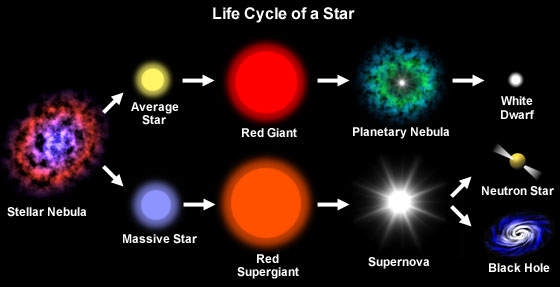Life Cycle of a Star
- All stars form in nebulae, which are huge clouds of gas and dust. Though they shine for many thousands, and even millions of years, stars do not last forever.
- The changes that occur in a star over time and the final stage of its life depend on a star’s size.
- Nuclear reactions at the centre (or core) of a star provides energy which makes it shine brightly. This stage is called the ‘main sequence’.
- The exact lifetime of a star depends very much on its size.
- Very massive stars use up their fuel quickly. This means they may only last a few hundred thousand years. Smaller stars use up fuel more slowly so will shine for several billion years.
- Eventually, the hydrogen which powers the nuclear reactions inside a star begins to run out. The star then enters the final phases of its lifetime.
- All stars will expand, cool and change colour to become a red giant. What happens next depends on how massive the star is.
- A smaller star, like the Sun, will gradually cool down and stop glowing. During these changes it will go through the planetary nebula phase, and white dwarf phase.
- After many thousands of millions of years it will stop glowing and become a black dwarf.
- A massive star experiences a much more energetic and violent end. It explodes as a supernova. This scatters materials from inside the star across space. This material can collect in nebulae and form the next generation of stars.
- After the dust clears, a very dense neutron star is left behind. These spin rapidly and can give off streams of radiation, known as pulsars.
- If the star is especially massive, when it explodes it forms a black hole.

Tag:gs 3, Life Cycle of a Star, Nebulae, space
Subscribe
Login
0 Comments
